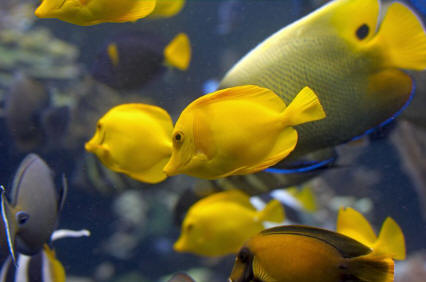Red Tail Giant Gourami

|
Scientific Name: Osphronemus laticlavius Price: Upon Request Origin: Asia Family: Osphronemidae NOT AVAILABLE NOW |
|
Other Names: Giant Red Finned Gourami, Red Flag Giant Gourami, Giant Red Fin Goramy |
|
Technical Info
Temperature: 23 - 27 ℃
pH: 6.8 - 7.5
GH: 4 - 10
Max size: 50 cm
Min Tank size: 600 Ltr
Position in Aqua: Top swimmer
Description
The Giant Red Tail Gourami is laterally compressed with a deep oval shaped body and a blunt head. As adults they develop a 'nuchal hump', a swollen knob or lump on the forehead. Like all other gouramis they have a special 'labyrinth organ' which enables them to survive in oxygen-depleted waters. This organ is a part of the fish which allows it to absorb atmospheric oxygen directly into the bloodstream by gulping air at the surface of the water. Juveniles have a steely blue gray to black color. As they mature they develop wonderful blue-green highlights and fins that are trimmed in red.
Food
Omnivorous and unfussy. O. laticlavius will accept most foods offered, including pellets, frozen foods and vegetable matter. Ensure the fish receive plenty of the latter, as it is primarily herbivorous in nature.
Breeding
Not yet reported in aquaria, but probably breeds in a similar fashion to its cousin O. goramy. In that species, the male builds a large nest out of vegetation (including grasses and roots in nature). Spawning occurs in the vicinity of the nest and the eggs are then taken there by the male. The female is chased away at this point. The eggs hatch in 24-36 hours and the fry become free swimming 3-5 days later. The male continues to guard them for 2-3 weeks in the wild but can be removed from the aquarium once the young are free swimming. They are large enough to accept brine shrimp nauplii and powdered flake from the first day. Obviously an enormous aquarium, or perhaps a tropical pond, would be required for any serious breeding attempt.
Compatible with
Will eat smaller fish but is generally peaceful with other large fish. Some adults may become very aggressive but this is often due to being kept in an aquarium that is too small. Given plenty of room this fish will usually coexist with tankmates such as knifefish, large barbs, catfish and Loricariids.

